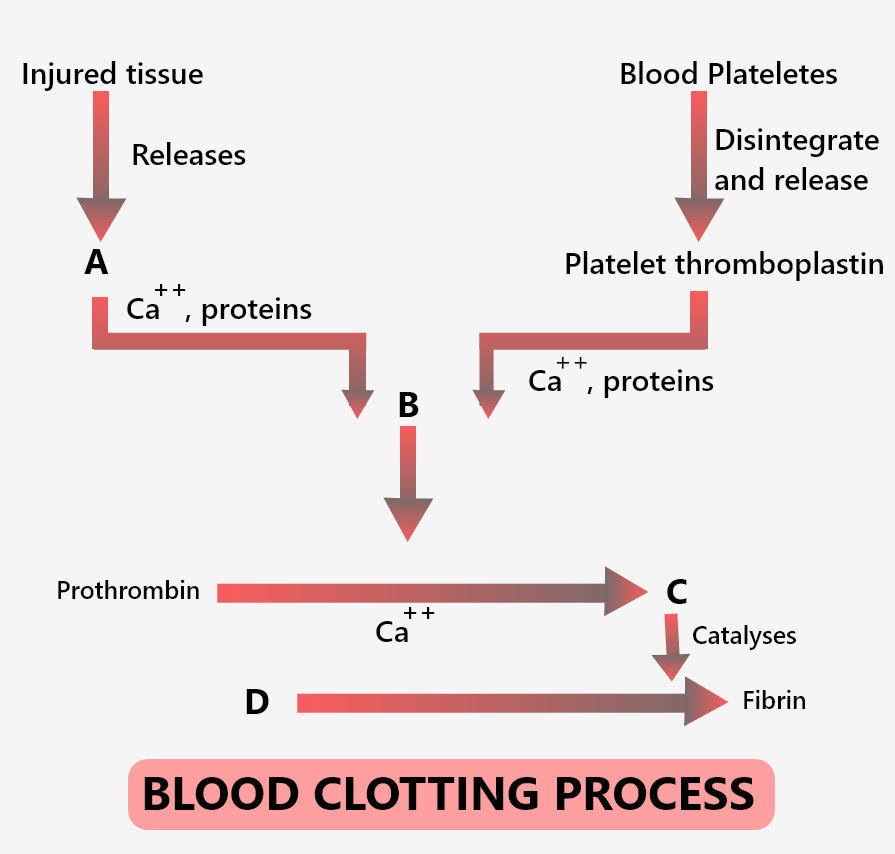
In the extrinsic clotting pathway, the active factor VII activates which factors?
A. X and XI
B. IX and XI
C. IX and X
D. XI and XII
Answer
459.3k+ views
Hint: Deficiency of this factor (clotting protein)is responsible for Christmas disease which is a genetic disorder. The extrinsic clotting pathway is one of the shortest pathways of secondary hemostasis. After the damage is done to the vessels the release of tissue factor by the endothelial cells takes place and this release furtherly activates the factors for clotting.
Complete answer:
The extrinsic route is the shortest route for secondary hemostasis. Once the vessel is damaged, endothelial cells release tissue factor which then activates factor VII into factor VIIa. Factor VIIa now activates factor X into factor Xa
Additional information: Recombinant activated factor VII (factor VIIa) is indicated in patients with inhibitors of coagulation factors VIII and IX. Therefore, FVIIa exists only in a partially active form and is entrained in the active glycoprotein (50 kDa) involved in the extrinsic pathway of blood coagulation.

Factor VII is the most sensitive of the vitamin K dependent coagulation factors. The mode of action is tissue factor-dependent activation of factors Xa and IXa on activated platelet surfaces. Factor Xa leads to the generation of thrombin and hemostasis, by converting fibrinogen into fibrin.
So, the correct answer is IX and X.
Note: After vascular injury, tissue factor is exposed to circulating blood and factor VII. Once bound to TF, FVII is activated to FVIIa by various proteases, including thrombin (factor IIa), factor Xa, IXa, XIIa, and the FVIIa-TF complex itself. Some of the factors that affect the blood clotting factor are Fibrinogen which is factor 1, Prothrombin which is factor 2, thromboplastin which is factor 3, calcium which is factor 4, Proaccelerin or Labile Factor which is factor 5, Stable Factor which is factor 6 and many more factors are involved in the blood clotting.
Complete answer:
The extrinsic route is the shortest route for secondary hemostasis. Once the vessel is damaged, endothelial cells release tissue factor which then activates factor VII into factor VIIa. Factor VIIa now activates factor X into factor Xa
Additional information: Recombinant activated factor VII (factor VIIa) is indicated in patients with inhibitors of coagulation factors VIII and IX. Therefore, FVIIa exists only in a partially active form and is entrained in the active glycoprotein (50 kDa) involved in the extrinsic pathway of blood coagulation.

Factor VII is the most sensitive of the vitamin K dependent coagulation factors. The mode of action is tissue factor-dependent activation of factors Xa and IXa on activated platelet surfaces. Factor Xa leads to the generation of thrombin and hemostasis, by converting fibrinogen into fibrin.
So, the correct answer is IX and X.
Note: After vascular injury, tissue factor is exposed to circulating blood and factor VII. Once bound to TF, FVII is activated to FVIIa by various proteases, including thrombin (factor IIa), factor Xa, IXa, XIIa, and the FVIIa-TF complex itself. Some of the factors that affect the blood clotting factor are Fibrinogen which is factor 1, Prothrombin which is factor 2, thromboplastin which is factor 3, calcium which is factor 4, Proaccelerin or Labile Factor which is factor 5, Stable Factor which is factor 6 and many more factors are involved in the blood clotting.
Recently Updated Pages
How to find how many moles are in an ion I am given class 11 chemistry CBSE

Class 11 Question and Answer - Your Ultimate Solutions Guide

Identify how many lines of symmetry drawn are there class 8 maths CBSE

State true or false If two lines intersect and if one class 8 maths CBSE

Tina had 20m 5cm long cloth She cuts 4m 50cm lengt-class-8-maths-CBSE

Which sentence is punctuated correctly A Always ask class 8 english CBSE

Trending doubts
The reservoir of dam is called Govind Sagar A Jayakwadi class 11 social science CBSE

10 examples of friction in our daily life

What problem did Carter face when he reached the mummy class 11 english CBSE

Difference Between Prokaryotic Cells and Eukaryotic Cells

State and prove Bernoullis theorem class 11 physics CBSE

What organs are located on the left side of your body class 11 biology CBSE




